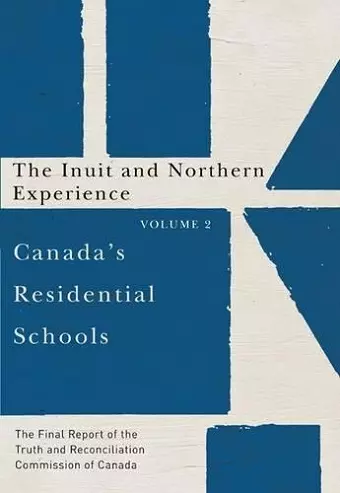Canada's Residential Schools: The Inuit and Northern Experience
The Final Report of the Truth and Reconciliation Commission of Canada, Volume 2
Truth and Reconciliation Commission of Canada author
Format:Hardback
Publisher:McGill-Queen's University Press
Published:9th Dec '15
Currently unavailable, our supplier has not provided us a restock date

Between 1867 and 2000, the Canadian government sent over 150,000 Aboriginal children to residential schools across the country. Government officials and missionaries agreed that in order to "civilize and Christianize" Aboriginal children, it was necessary to separate them from their parents and their home communities. For children, life in these schools was lonely and alien. Discipline was harsh, and daily life was highly regimented. Aboriginal languages and cultures were denigrated and suppressed. Education and technical training too often gave way to the drudgery of doing the chores necessary to make the schools self-sustaining. Child neglect was institutionalized, and the lack of supervision created situations where students were prey to sexual and physical abusers. Legal action by the schools' former students led to the creation of the Truth and Reconciliation Commission of Canada in 2008. The product of over six years of research, the Commission's final report outlines the history and legacy of the schools, and charts a pathway towards reconciliation. Canada's Residential Schools: The Inuit and Northern Experience demonstrates that residential schooling followed a unique trajectory in the North. As late as 1950 there were only six residential schools and one hostel north of the sixtieth parallel. Prior to the 1950s, the federal government left northern residential schools in the hands of the missionary societies that operated largely in the Mackenzie Valley and the Yukon. It was only in the 1950s that Inuit children began attending residential schools in large numbers. The tremendous distances that Inuit children had to travel to school meant that, in some cases, they were separated from their parents for years. The establishment of day schools and what were termed small hostels in over a dozen communities in the eastern Arctic led many Inuit parents to settle in those communities on a year-round basis so as not to be separated from their children, contributing to a dramatic transformation of the Inuit economy and way of life. Not all the northern institutions are remembered similarly. The staff at Grandin College in Fort Smith and the Churchill Vocational Centre in northern Manitoba were often cited for the positive roles that they played in developing and encouraging a new generation of Aboriginal leadership. The legacy of other schools, particularly Grollier Hall in Inuvik and...
"These volumes contain a tremendous amount of information and data. Of special interest are the first-person accounts and the black-and-white photographs taken at the various schools. Anyone interested in Canadian history and the history of Native peoples will be intrigued by these publications, which are sure to be eye-opening." - Library Journal
ISBN: 9780773546530
Dimensions: unknown
Weight: unknown
266 pages